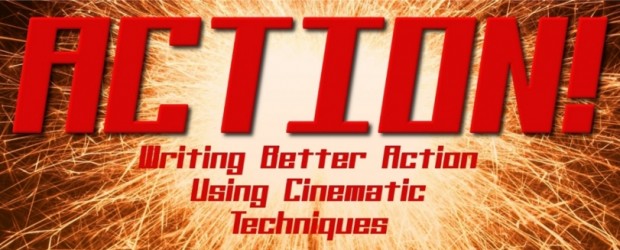The Shootout
or, “PEW PEW PEW!”
Once upon a time, humans developed technology that allowed us to stand away from our opponents and kill them at a distance. Ever since then, we’ve been obsessed with ranged combat in all its myriad forms.
In fiction, there are three rather broad categories of ranged weapons, roughly equivalent to the past, the present, and the future: arrows, bullets, and lasers. Note that these are personal hand weapons as opposed to large siege engines requiring a crew, for example; those fall under a different style of action scene which will be discussed later. Arrows in this circumstance refers to any kind of pre-gunpowder projectile, either thrown, slung, or launched using string tension. Bullets mean any projectile fired using gunpowder (or a variation thereof). Lasers refer to any kind of futuristic energy weapon based upon technology not yet invented.
Action scenes involving ranged combat are similar in setup to Fights. You still need to work out the details of the set piece and where your characters fit within that area. The primary difference between a Shootout and a Fight is the distance between the opponents. No matter what type of weapon in use during a Shootout, the goal of each character should be the same: Shoot your opponent before your opponent shoots you.
Stunts in Shootouts will generally fall under the following categories:
- Shooting your weapon at your opponent.
- Moving through fire between cover to close or increase the distance between you and your opponent.
- Using the set piece to your advantage, ie: taking cover, moving to high ground, or shooting set piece elements to change the outcome of the shootout. Example: firing an arrow through a rope supporting a heavy cask which then falls upon your opponent, catching him unawares.
Narrating a Shootout works best in either first-person or third-person close. If you’re beginning to detect a pattern here in using limited points-of-view for action scenes, you’re right. The further apart characters get in physical distance, the harder it is to provide effective narration from an omniscient point of view.
A Shootout ends when one side dies, surrenders, or escapes.
There are some factors in Shootouts which an author needs to pay more attention to than in a simple Fight. The first of these is Cover. Cover is a portion of the set piece behind which a character can hide to make it harder to hit him or her with a ranged weapon. It is the single most important factor for any character in a Shootout. If you can’t see your opponent, you can’t shoot him. Cover protects characters from enemy fire. It gives them a place to plan their next moves, which is something an author should take full advantage of when writing the scene. It also gives them a place to pop up/out from to fire their own weapons. Cover may be static set pieces, like wall corners, tree trunks, car doors (although a staple of cop shows and movies, not recommended because bullets go right through them), rocks, etc. They may also be mobile pieces, such as animals, vehicles, or the ever-popular human shield. In the event a character is using a mobile set piece for cover, he or she will have to move with it, or guide it if possible.
Another important factor in a Shootout is ammunition. Although you don’t need to keep track of every arrow and shot fired in every situation, there will be times where that becomes important and you need to know when your character either has to reload or is out of ammunition, necessitating a change of plans. If you, the author, want to have your characters run out of ammunition at a crucial part of a scene, make sure they fire enough arrows/bullets/lasers beforehand. A soldier in a pitched battle in World War II, for example, has access to a great many rounds of ammunition, either his own or from fallen comrades. The same soldier who’s parachuted down behind enemy lines may only have six bullets with which to fight his way back to his allies. Reloading a weapon is always a good opportunity for characters to interact with other characters, whether whispering to each other behind cover about their next move or shouting across open space to taunt opponents.
Wounds are a big factor of any action scene, but they have a special place in the Shootout. Injuries that happen in the course of a Fight often have their effects minimized until after the engagement because of adrenaline, guts, or whatever the fiction equivalent is in your world. In a Shootout, wounds are much more immediate, often painful and possibly quite damaging. The character is under high stress from being in a combat situation, but if he is behind cover and takes a bullet, he will have much more time to realize how much it hurts and how badly he may have been wounded. Because of the penetrating nature of ranged projectiles, victims in Shootouts may find themselves peppered with buckshot, grazed by bullets, pierced by arrows or spears, or burned and charred by lasers or blasters. As a writer, it is imperative to take full advantage of those opportunities to make your characters more believable and bring the readers closer to them.

good article
Wonderfully written article that has provoided me with the best information yet.